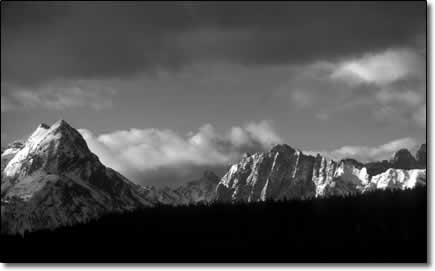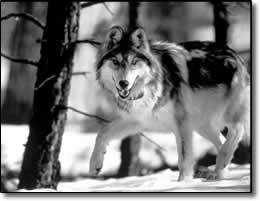|
Local area central to current wolf discussion

|
|
The San Juan Mountains, above, are central to a current discussion on the eventual arrival of reintroduced wolves in Colorado. Because of their close proximity to Arizona and New Mexico, as well as their large tracts of wilderness and roadless areas, the San Juans are viewed as potential prime wolf habitat./Photos by Jared Boyd.
|
by Shawna Bethell
In 1949, four years after the last wolf was eradicated from the southern San Juan Mountains,
Aldo Leopold wrote, "Only the mountain has lived long enough to listen objectively to the howl of the wolf." In 2005,
little has changed in this regard. However, with the knowledge that wolves reintroduced to the northern Rocky
Mountain states and New Mexico and Arizona will make their way to Colorado, the Colorado Division of Wildlife (CDOW)
appointed a 14-member Wolf Management Working Group to address the issue of managing wolves. This group, comprised of
four livestock producers, four wildlife advocates, two wildlife biologists, two sportsmen, and two local government
officials, was asked to put aside personal emotion and work together to create a recommended plan for wolf management
in Colorado. To their credit, the members of this group agreed they would utilize consensus in finalizing their
recommendations to the state.
Mark Pearson, executive director of the San Juan Citizens Alliance in Durango, is a member of the working group. "The
issue of wolves in the San Juan Mountains is a social one, not a biological one," he said. "Biologically speaking, if
they are not persecuted, wolves will thrive in the San Juans. We have the best habitat and abundant populations of
elk and other ungulates."
Pearson also explained that the San Juans have the largest roadless areas and the largest wilderness areas in the
state which will act to keep wolves and people separate. There may be a negative economic impact on a handful of
livestock operators who have grazing permits on public lands, and there is a recommendation that proven wolf
predations are financially compensated for. But Pearson also pointed out that wolves draw tourist dollars as
exemplified in Yellowstone National Park, where tourists come by the thousands just to hear the call of a wolf.
Pearson's comments somewhat exemplify what has happened and what is happening in the dialogue over this predator's
very existence: a constant tallying of costs and benefits, passions and fears, that has literally been in debate for
the greater part of this century. No other predator has been as hated, tortured, mythologized or romanticized as the
wolf, and that passion and fury, which was eradicated from this state in the '40s, is resurging. It is only through a
great deal of effort and communication on all parts that the state is being proactive on how to best handle the
return of canis lupus.
At this time, the numbers of wolves migrating into the state is thought to be small; in fact the female killed on
I-70 in June of 2004 is the only documented wolf sighting in Colorado since the reintroduction. Still, the working
group, taking into consideration that over time wolves may naturally recolonize, has recommended that migrating
wolves be allowed to "live with no boundaries where they find habitat," and that "wolf distribution in Colorado will
ultimately be defined by the interplay between ecological needs and social tolerance." To that end, if problems
occur, they will be addressed on a case-by-case basis, utilizing a combination of "management tools" and "damage
payments." The extensive document created by the working group assesses ecological benefits, economic benefits and
losses, social and cultural challenges, law enforcement, management tools, and an abundance of other issues. But the
politics of wolves is a bit more of a quagmire. The federal government has expressed interest in delisting the wolf
from endangered status and hand over wolf management to state jurisdictions. To do that, numbers must increase.
Currently, there is no definite plan to reintroduce wolves to Colorado, but a second team of individuals set up by
the Federal Fish and Wildlife Division, with member interests similar to those of the working group, has been
convened to look at multi-state regions and consider where wolves could be introduced safely and successfully.
According to Michael Robinson, of the Center for Biological Diversity in New Mexico who is also a member of the
Recovery Team, the San Juan Mountains are on a short list of possibilities.
"Top-level carnivores are essential to the ecological system," stated Rob Edward, director of the Carnivore
Restoration Program of Sinapu. "What wolves reestablish is the 'ecology of fear.'" Currently, high density ungulate
populations hang out for extended periods of time grazing near waterways, impacting willow and aspen growth. If
wolves are part of the ecological system, the ungulates are on the move allowing the flora to regenerate, which in
turn allows more forage for beavers, more over story for songbirds, improved water quality and improved fish
populations. Wolves are also known to cull ungulate herds of sickly and weak individuals keeping the populations
healthy.

|
|
Mexican gray wolves, much like this one here, may soon become a fixture of the San Juan mountains if reintroduced animales make their way over statelines from Arizona and New Mexico./Photo Courtesy U.S. Fish & Wildlife Service
|
"Top-level carnivores are essential to the ecological system," stated Rob Edward, director of the Carnivore
Restoration Program of Sinapu. "What wolves reestablish is the 'ecology of fear.'" Currently, high density ungulate
populations hang out for extended periods of time grazing near waterways, impacting willow and aspen growth. If
wolves are part of the ecological system, the ungulates are on the move allowing the flora to regenerate, which in
turn allows more forage for beavers, more over story for songbirds, improved water quality and improved fish
populations. Wolves are also known to cull ungulate herds of sickly and weak individuals keeping the populations
healthy.
"We are lucky," said Edward. "We have watched other places where this debate has raged, and we can learn from their
programs, from their mistakes."
Wolves and the San Juans
Wolves will be in the spotlight in La Plata County this
week. First, Rob Edward, director of the Carnivore
Restoration Program of Sinapu, will give an informative
lecture on "Wolves and Stewardship in the San Juan
Mountains.” Sponsored by the Fort Lewis College
Environmental Center, the talk takes place Thurs., Feb. 3,
at 7 p.m. in Room 135 of Noble Hall.
Early next week, the Colorado Division of Wildlife will
present the findings of the Wolf Management Working
Group locally. The meeting will be held in Durango on
Mon., Feb. 7, at 7 p.m. at the Double Tree Hotel, 501
Camino Del Rio. The public is encouraged to attend.
|
|
Duke Phillips, of Chico Basin Ranch located in the San Luis Valley, is also part of the working group, and his
dedication to healthy ecosystems is exemplified by his ranch's implementing such practices as duplicating natural
bison grazing patterns. He feels that being part of the group was an opportunity to make contact with people and put
an end to bad blood.
"Ranchers already live on the land, and they can play an important role in improving the health of the natural
world," he said. But he also has questions when it comes to the possibility of a full-out reintroduction and how
wolves would impact an ecosystem that has evolved without them and how they would live in a system now heavily
populated with humans.
Though there has been no official statement from the Southern Ute Tribe on the issue of wolves being allowed to
reintegrate or be recovered in the region, Steve Whiteman, director of wildlife management for the Southern Ute
tribe, says that as a biologist he doesn't think attitudes have changed much since wolves were extirpated from the
region in the '40s. "I see the potential if not likelihood of wolves migrating to the area, but I think it will be a
challenge for wildlife agencies to see that this succeeds in the Four Corners region," he said. "They will need to
utilize a lot of education and be willing to financially compensate for any livestock killed by wolves."
As for tribal members, he sees that they may respond similarly to any other group in the region. Some members may,
because of cultural beliefs, be gratified to see the wolf return, others with livestock responsibilities may not.
Overall, the population of Colorado does support the idea of wolf populations in the state. In a 1994 statewide
survey, 71 percent of respondents said they wished to catch a glimpse of a wolf loping through the mountains. But the
Division of Wildlife is not relying solely on those percentages. They are now seeking public comment on the
recommendations of the Wolf Management Working Group and tapping the public pulse throughout the state to that end.
|